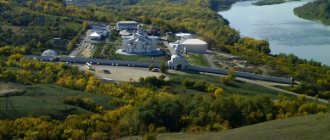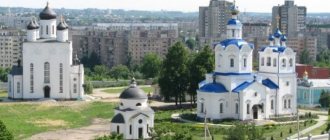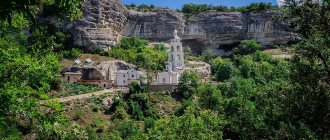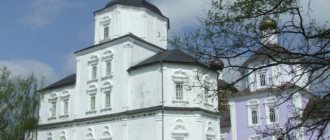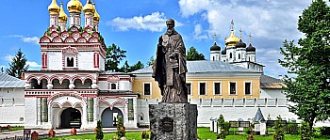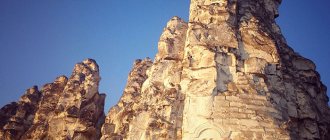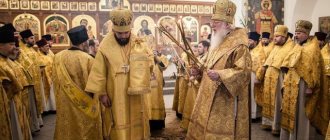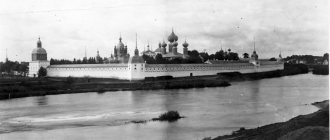Mir
Ukraine Odessa region Odessa Holy Dormition Odessa Patriarchal Monastery Map is loading…
{"format":"leaflet","minzoom":false,"maxzoom":false,"limit":50,"offset":0,"link":"all","sort":[""], "order":[],"headers":"show","mainlabel":"","intro":"","outro":"","searchlabel":"\u2026 \u0441\u043b\u0435\ u0434\u0443\u044e\u0449\u0438\u0435 \u0440\u0435\u0437\u0443\u043b\u044c\u0442\u0430\u0442\u044b","default":"","import-annotation":false,"width ":"auto","height":"350px","centre":{"text":"","title":"""link":"""lat":46.37844799999999878536982578225433826446533203125,"lon": 30.7450919999999996434780769050121307373046875,"icon":""},"title":"","label":"","icon":"","lines":[],"polygons":[],"circles":[ ],"rectangles":[],"copycoords":false,"static":false,"zoom":8,"defzoom":14,"layers":["OpenStreetMap"],"image layers":[] ,"overlays":[],"resizable":false,"fullscreen":true,"scrollwheelzoom":true,"cluster":false,"clustermaxzoom":9,"clusterzoomonclick":true,"clustermaxradius":80, "clusterspiderfy":true,"geojson":"","clicktarget":"","showtitle":true,"hidenamespace":false,"template":"","userparam":"","activeicon": "","pagelabel":false,"ajaxcoordproperty":"","ajaxquery":"","locations":[{"text":"\u003Cb\u003E\u003Ca href=\"/palomnik/%D0% A1%D0%B2%D1%8F%D1%82%D0%BE-%D0%A3%D1%81%D0%BF%D0%B5%D0%BD%D1%81%D0%BA%D0%B8 %D0%B9_%D0%9E%D0%B4%D0%B5%D1%81%D1%81%D0%BA%D0%B8%D0%B9_%D0%9F%D0%B0%D1%82%D1 %80%D0%B8%D0%B0%D1%80%D1%88%D0%B8%D0%B9_%D0%BC%D1%83%D0%B6%D1%81%D0%BA%D0%BE %D0%B9_%D0%BC%D0%BE%D0%BD%D0%B0%D1%81%D1%82%D1%8B%D1%80%D1%8C\" title=\"\u0421\u0432 \u044f\u0442\u043e-\u0423\u0441\u043f\u0435\u043d\u0441\u043a\u0438\u0439 \u041e\u0434\u0435\u0441\u0441\u043a\u0438\u0439 \u041f\u0430\u0442\u0440\ u0438\u0430\u0440\u0448\u0438\u0439 \u043c\u0443\u0436\u0441\u043a\u043e\u0439 \u043c\u043e\u043d\u0430\u0441\u0442\u044b\u0 440\u044c\»\u003E\u0421\ u0432\u044f\u0442\u043e-\u0423\u0441\u043f\u0435\u043d\u0441\u043a\u0438\u0439 \u041e\u0434\u0435\u0441\u0441\u043a\u0438\u0 439\u041f\u0430\u0442\u0440 \u0438\u0430\u0440\u0448\u0438\u0439 \u043c\u0443\u0436\u0441\u043a\u043e\u0439 \u043c\u043e\u043d\u0430\u0441\u0442\u044b\ u0440\u044c\u003C/a\u003E \u003C/b\u003E\u003Chr /\u003E\u003Ca href=\"/palomnik/%D0%A1%D0%B2%D0%BE%D0%B9%D1%81%D1%82%D0%B2%D0 %BE:%D0%90%D0%BD%D0%BD%D0%BE%D1%82%D0%B0%D1%86%D0%B8%D1%8F\» title=\»\u0421\u0432\ u043e\u0439\u0441\u0442\u0432\u043e:\u0410\u043d\u043d\u043e\u0442\u0430\u0446\u0438\u044f\u003E\u0410\u043d\u043d\u043e\u 0442\u0430\u0446\u0438 \u044f\u003C/a\u003E: \u043f\u0440\u0430\u0432\u043e\u0441\u043b\u0430\u0432\u043d\u044b\u0439 \u043c\u0443\u0436\u0441\u04 3a\u043e\u0439 \u043c\ u043e\u043d\u0430\u0441\u0442\u044b\u0440\u044c \u0432 \u0447\u0435\u0441\u0442\u044c \u0423\u0441\u043f\u0435\u043d\u0438\u 044f\u041f\u0440\u0435\u0441\ u0432\u044f\u0442\u043e\u0439 \u0411\u043e\u0433\u043e\u0440\u043e\u0434\u0438\u0446\u044b \u0432 \u0433\u043e\u0440\u043e\u 0434\u0435\u041e\u0434\u0435\ u0441\u0441\u0430 \u041e\u0434\u0435\u0441\u0441\u043a\u043e\u0439 \u0435\u043f\u0430\u0440\u0445\u0438\u0438. \u041f\u0440\u0438 \u043e\u0431\u0438\u0442\u0435\u043b\u0438 \u0438\u043c\u0435\u0435\u0442\u0441\u044f \u0433\u043e\u0441 \u0442\u0438\u043d\u0438\u0446 \u0430 \u0434\u043b\u044f \u043f\u0430\u043b\u043e\u043c\u043d\u0438\u043a\u043e\u0432.","title":"\u0421\u0432\u044f\u0442\u043e -\u0423\ u0441\u043f\u0435\u043d\u0441\u043a\u0438\u0439 \u041e\u0434\u0435\u0441\u0441\u043a\u0438\u0439 \u041f\u0430\u0442\u0440\u0 438\u0430\u0440\u0448\u0438\ u0439 \u043c\u0443\u0436\u0441\u043a\u043e\u0439 \u043c\u043e\u043d\u0430\u0441\u0442\u044b\u0440\u044c","link":"","lat":46.3784479 9999999878536982578225433826446533203125,”lon ":30.7450919999999996434780769050121307373046875,"icon":""}],"imageLayers":[]}
46.378448; 30.745092
Ukraine, Odessa, Monastyrsky lane, 6
Odessa, Odessa region
Ukraine
Telephone:
(048) 746–30–39
Holy Dormition Odessa Patriarchal Monastery
—
Holy Dormition Odessa Patriarchal Monastery
alt=Holy Dormition Odessa Patriarchal Monastery
The rector of the monastery is the ruling bishop of the Odessa diocese.
History[edit]
In 1814, Metropolitan Gabriel, with the permission of the Holy Synod, founded a bishop’s courtyard on land donated by the Moldavian nobleman Alexander Teutul, which later received the name “Big Fountain”. In 1824, the courtyard was converted into a monastery in honor of the Dormition of the Blessed Virgin Mary.
On June 1, 1824, the monastery was approved as a second-class monastery.
At first, a small wooden church was built, and later, in 1825, a stone two-altar cathedral was erected in its place. The main altar of the cathedral was dedicated to the Dormition of the Blessed Virgin Mary.
In 1834, with donated funds from the Odessa merchant Daria Kharlambu, a second monastery church with a bell tower was built in honor of the Icon of the Mother of God “Life-Giving Source” (now the Assumption).
After 1834, the monastery brethren built at their own expense a small, third, church in the name of St. Nicholas the Wonderworker. And in the 1890s it was rebuilt and updated.
In 1880, under Archbishop Platon (Gorodetsky) of Kherson and Odessa, a vicariate was opened to help the Odessa archpastors. The vicar bishop bore the title “Elisavetgradsky” and his seat was in the Odessa Dormition Monastery.
Around 1920, a fraternal building was added to the eastern side of St. Nicholas Church.
In 1922, the monastery property, all valuables and shrines were completely confiscated by the state. In 1922, the Assumption Monastery was occupied by renovationists.
After 1936, the main shrine of the monastery - the temple in honor of the Dormition of the Mother of God - was blown up. In its place in 1953, a water-sanctuary chapel with a monastery spring was built.
After the liquidation of Soviet power in 1942, one of the monastery churches was reopened, and in 1944 the monastery was completely revived. Since the main cathedral of the monastery was destroyed, the main church of the monastery became the Church of the Life-Giving Source, which during its revival was consecrated in the name of the Dormition of the Mother of God.
Since 1946, the summer residence of the Patriarchs of Moscow and All Rus' has been established here, and therefore the monastery began to be called the Patriarchal Monastery. Only this saved the monastery from being closed again in 1961, at the height of new persecution of the Church in the USSR.
A bishop's hotel was built on the territory of the Patriarchal residence in 1951.
Since 1960, the Monk Kuksha of Odessa labored in the monastery; Metropolitan John (Kukhtin) and Archbishop Onisiphorus (Ponomarev) lived in retirement. Since 1961, the Odessa Theological Seminary has been located in the monastery. The seminary has a church in honor of St. Apostle Andrew the First-Called, the heavenly patron of the seminary.
In 1965, the residence of the ruling bishop of the Odessa diocese, who is its holy archimandrite and rector of the monastery, was moved to the monastery.
In 1967, in the chambers of the summer residence of the Patriarch of Moscow and All Rus', a small cross church was built, sacred in honor of the Monks Sergius and Nikon, abbots of Radonezh, miracle workers of All Rus'.
In 1988, in the year of the 1000th anniversary of the Baptism of Rus', a dome and bell tower were built over the St. Nicholas Church.
Story
The monastery appeared in Odessa in 1824, but in the first year it could not boast of beauty and grandeur. Even the temple on its territory was wooden. The stone Cathedral of the Assumption of the Mother of God with two domes appeared only the next year. Later, large-scale construction was launched on the territory of the monastery, around the main cathedral, which resulted in the appearance of a monastery church, a building for monks, a bell tower, and various outbuildings.
A difficult period for the monastery and its brothers began with the advent of Soviet power. Already in 1922, all monastery property and valuables were nationalized in favor of the state. After 12 years, in the wake of the fight against religion, the main temple was also destroyed.
The work of the monastery was restored only in 1942, during the German occupation. At the same time, the residence of the local patriarch and a seminary for training clergy appeared here.
© Official VKontakte page
Description[edit]
In 2005-2007 The main entrance to the monastery is designed in the form of a 53-meter bell tower, where above St. The temple of St. is consecrated with gates. the passion-bearing princes Boris and Gleb (2008). From here a straight alley leads south, deep into the monastery. In the central part of the monastery, on the eastern side of the alley, there is a church of St. Nicholas of Myra. “The General Illustrated Guide to Monasteries and Holy Places of the Russian Empire and Mount Athos” of 1907 reports that the St. Nicholas Church was built after 1834 and became the third in the monastery, but oral tradition says that it appeared earlier than the others: perhaps after 1834 only the reconstruction of the temple was carried out.
Bell tower of the Holy Dormition Patriarchal Monastery
OK. In 1920, a fraternal building was added to it, which is still under the same roof with it. After the abolition of the monastery, the temple was closed, and in 1942 services were resumed here. In the beginning. 1960s in the adjacent fraternal building, across the wall from the church, lived St. Kuksha. In 1988, the temple was crowned with a dome. On the same side of the alley, south of St. Nicholas Church, is the Church of the Assumption of the Blessed Virgin Mary. It was built in 1834 and was first named in honor of the icon of the Mother of God “Life-Giving Spring” - probably because of the abundance of water springs around the monastery. In 1942, the temple was named Assumption (in the 1950s, the bell tower built over it was dismantled due to its disrepair). The renaming of the temple is due to the fact that there was another Assumption Church in the monastery, consecrated in 1825 and destroyed after 1936. In its place, in 1998-2010. a grandiose cathedral of the Icon of the Mother of God “Life-Giving Source” was built with a lower church in the name of St. Kuksha of Odessa.
To the south of the Assumption Church there is a monastery cemetery. Many devotees of the monastery and Odessa bishops are buried here (the coffins of some bishops were moved in 1987 from the Slobodskoye cemetery, where they ended up in the 1930s due to the destruction of the Transfiguration Cathedral). On December 24, 1964, St. Petersburg was buried in the monastery cemetery. Kuksha. When the elder died, the civil authorities, not wanting to allow a crowd of people to attend the funeral, insisted on transporting the coffin to the Kherson region - the homeland of Fr. Kukshi. The abbot of the monastery replied: “The monk’s homeland is a monastery!” Then the authorities gave the monks 2 hours for the funeral. I had to obey. The elder rested at 2 a.m., and at 2 p.m. at the grave of Fr. Kukshi already had a cross. St. Kuksha, having the gift of foresight, foresaw this and said: “They will bury it the way they will: quickly, quickly, they will take spatulas and bury it.” And one day, coming to the cemetery and pointing to one of the places, he said: “They will dig my grave here, but I will not lie here, a coffin is buried in this place, and they will dig a hole for me next to it.” These words came true. Praying at the elder’s grave and taking handfuls of earth from it, the spiritual children of Fr. Kukshi and other believers found relief from sorrows in their souls and were healed from bodily ailments. September 29, 1994 the relics of St. The Kukshas were found and rest in one of the monastery churches. In 2006, a wooden chapel of Sts. was built at the cemetery. mcc. Faith, Hope, Love and their mother Sophia.
One of the famous buildings of the monastery is the one built in the 2nd floor. 1940s summer Patriarchal residence, where in 1967 the Cross Church of St. Sergius and Nikon of Radonezh. A separate complex of buildings is the Odessa Theological Seminary. In 1967, the Church-Archaeological Cabinet (collection of church antiquities) was created here; in 1980, the Church of St. ap. Andrew the First-Called. In 2009, construction began on a new hotel for pilgrims.
Temples and architectural ensemble of the monastery
With its architecture, the Holy Dormition Monastery in Odessa attracts attention at first sight. At the entrance there is an impressive bell tower, rising 53 meters above the ground. From the bell tower, along an alley hidden in the shade of trees, you can go directly to the Church of St. Nicholas of Myra, the second most important object on the territory of the complex. Next door is the main cathedral, completely restored after destruction.
The southern part of the monastery territory is reserved for a cemetery, where not only the monastery ministers, but also the city bishops are buried. Hieromonk Vladimir and several other people canonized are buried in the complex. An important place is also given to the residence of the patriarch, which is an example of interesting and non-standard architecture.
One of the main architectural attractions of Odessa is the belfry with the gate temple in honor of the holy princes-passion-bearers Boris and Gleb. The 53-meter bell tower contains 15 bells, the largest of which was cast in Donetsk and weighs almost five tons. To help the bell ringers, a special apparatus with levers, keys and pedals was installed.
© Roman Kurortny
In 1834, the Church of the Assumption of the Blessed Virgin Mary was built - one of the few buildings of the monastery not destroyed by the Bolsheviks in the 1930s. Previously, the temple was called the “Life-Giving Source” icon of the Mother of God.
The Church of St. Nicholas the Wonderworker, built after 1834, became the third in the monastery. In 1988, a dome and a bell tower were added to it.
On the territory of the monastery there is the oldest theological school in the south of Ukraine - the Odessa Theological Seminary. At the seminary there is a temple in honor of St. Apostle Andrew the First-Called, as well as a collection of ancient church artifacts.
© Sergii Multipedia
The cathedral in honor of the Icon of the Mother of God “Life-Giving Spring” was built in 1998–2010, in compliance with the traditions of Russian architecture of the 16th century. Inside the temple there can be about 3,000 parishioners.
In the necropolis of the Holy Dormition Monastery lie the remains of ministers of the Russian Orthodox Church, as well as a number of ruling bishops of Odessa (19th and early 20th centuries).
Also on the territory of the monastery are:
- hotel,
- summer residence of the patriarch,
- chapel in honor of the great martyrs Vera, Nadezhda, Lyubov and their mother Sophia,
- many interesting small architectural forms.
At the entrance to the Holy Dormition Odessa Monastery: Google panorama
Shrines[edit]
- particle of the tree of the Holy Cross of the Lord
- part of Christ's robe
- part of the tunic of the Mother of God
- ark with the foot of St. ap. Andrew the First-Called
- ark with particles of saints' relics
- Icon of the Mother of God “Mammal” from Athonite writing of the 17th century. from St. Elias Church in Odessa
- Icon of the Mother of God “Quiet My Sorrows” from Athos writing
- Icon “Appearance of the Mother of God St. Sergius of Radonezh" (gift of His Holiness Patriarch Alexy I of Moscow and All Rus', †1970)
- the power of St. Kuksha of Odessa.
Holy Dormition Patriarchal Monastery in Odessa
The history of the emergence of the Odessa Holy Dormition Monastery is connected with the name of a famous church figure at the turn of the 18th-19th centuries. Metropolitan of Kyiv and Galicia Gabriel (Banulescu-Bodoni), Exarch of Moldova. It was Metropolitan Gabriel, at the founding of Odessa, in 1794, who performed a prayer service and laid the first stone of the “new city,” as well as the first stones for the founding of the first churches in Odessa. With the formation of the Kishinev See, Odessa began to be governed by the saints of Kishinev - until 1837, when the diocese of Kherson and Tauride was formed from part of the Kishinev diocese with the residence of the ruling archpastor in Odessa. And since 1860, after the founding of the Tauride diocese with a see in Simferopol, the bishop of the Kherson diocese began to be called Kherson and Odessa.
They say that in 1804, Metropolitan Gabriel met in Odessa the nobleman Alexander Teutul, who owned an estate on the Black Sea coast (now in the area of the 16th station of the Bolshoi Fontan). The estate was surrounded by orchards, vineyards and meadows - in a word, grace. However, the owner of the land apparently experienced acute discomfort after the tragedy that occurred in 1813, of which he himself unwittingly became the culprit. The fact is that one evening, while feasting with friends on the shore, he lit fires, and the Greek sailors, sailing to Odessa on a boat, mistook the lights for a lighthouse (in reality, located in a completely different place) and the ship crashed on the rocks. Teutul and his guests rushed to save the sailors, but few survived. A conscientious man, the nobleman Teutul generously gave gifts to the survivors and transferred his estate to the church for the construction of a temple and a lighthouse on this land. This is how in 1814 the Teutula estate became the metochion of the Chisinau bishop, who was then Metropolitan Gabriel; The lighthouse here was completed by 1827 by the civil maritime department. And in 1824 the courtyard was transformed into the Holy Dormition Monastery. In 1825, the consecration of the stone cathedral took place, which was erected on the site of the former wooden church. The main altar of the cathedral was consecrated in honor of the Dormition of the Blessed Virgin Mary. With the help of generous donors, the cathedral was decorated with a rich iconostasis, holy icons, and utensils. By this time, in addition to the majestic Holy Dormition Cathedral, a two-story bishop's house, a refectory, a kitchen, a hotel for visitors, a stone fence had already been built, wells had been built, and vineyards had been planted. In 1834, at the expense of the Odessa merchant of the 2nd guild Vladimir Kharlambu and his wife Daria, a second monastery church with a bell tower was built in honor of the “Life-Giving Spring” icon of the Mother of God. Since the former Holy Dormition Cathedral of the monastery was destroyed after 1936, the temple of the “Life-Giving Spring” was subsequently consecrated in honor of the Dormition of the Blessed Virgin Mary. In 1953, a water-blessing chapel was built on the site of the destroyed cathedral, which is still in use today. And after 1834, the monastery brethren, at their own expense, built a small third church in the name of St. Nicholas the Wonderworker. When Odessa became a cathedral city in 1837, His Eminence Gabriel (Rozanov) was appointed the first archpastor of Kherson and Tauride, who upon his arrival here settled for the first time in the Holy Dormition Monastery. During the Crimean War of 1853-1856. The brethren of the Holy Dormition Odessa Monastery took on the feat of prayer, praying to the Lord God, the Intercessor of the Christian race and the Patroness of monastics, the Most Holy Theotokos to repel the “invasion of foreigners”, to grant peace, to preserve the Orthodox faith and to save souls. In the XIX century. Odessa became a fairly large city, largely for the reason that the route of pilgrims to the Orthodox East ran through it: to the Holy Land and to Holy Mount Athos. Odessa was called “the gates of Jerusalem.” Here were the courtyards of the Athonite monasteries: Panteleimonovsky, Andreevsky, Ilyinsky. Therefore, the Holy Dormition Odessa Monastery began to play an important role for Orthodox pilgrims, for the life of the city and the entire south of the country. The changeable 20th century In the 1920s, Orthodox Odessa was split, many churches were occupied by renovationists. In 1922, the monastic property, all valuables and shrines were completely confiscated to help the starving, and monastic life also ceased. There wasn’t even a paten or communion cup left in the monastery. Soon the atheists blew up the main shrine of the monastery - the Assumption Church. The Holy Assumption Cathedral now houses various shrines of the monastery - the miraculous locally revered icon of the Mother of God “Mammal,” painted by Athonite monks in the 17th century, the icon “Appearance of the Mother of God to St. Sergius of Radonezh” (a gift from His Holiness Patriarch Alexy I), a piece of the Honest and Life-Giving Tree The Cross of the Lord, part of the robe of Christ the Savior, part of the tunic of the Blessed Virgin Mary, the ark with the relics of St. Andrew the First-Called (right foot), the ark with the relics of the holy righteous Anna, the mother of the Blessed Virgin Mary, the holy Apostle Luke, the holy protomartyr and archdeacon Stephen, the holy great martyr and healer Panteleimon and many other saints. Here is a shrine with the relics of the Monk Kuksha, about whom we will talk below. In St. Nicholas Church there is a Kasperovsky image of the Mother of God and an icon of St. Nicholas the Wonderworker. In old documents, a detailed description of the destroyed Holy Assumption Church was found, which was of extreme value: “The main temple is stone, single-domed. The front part is decorated with sacred images. It has three entrances: from the western, northern and southern sides. A porch is attached to the western entrance, the pediment of which is supported by four columns. Stone platforms are built at the northern and southern entrances...” Among the even row of crosses in the monastery cemetery, a white marble cross-monument stands out - above the grave of Metropolitan Boris (Vic). The revival of the monastery took place in 1944, and in 1946 the Odessa Theological Seminary opened, where Metropolitan Vladimir (Sabodan) of Kiev and All Ukraine studied from 1954 to 1958. A fellow student of Metropolitan Vladimir was Metropolitan Agafangel of Odessa and Izmail. It was under him that the first Odessa saints were canonized - Kuksha of Odessa and Gabriel of Athos, glorified on October 22 and 23, 1994. Since the 1940s, the monastery became a regular place of recreation for Patriarch Alexy I; the Patriarchs of Antioch, Alexandria and others often came here. Since those years, its former inhabitants began to return to their native monastery - already experienced in the crucible of persecution and trials. Many of them endured many years of confessional labor and endured camps and exile. Among them are schema-archimandrite Pimen (Tishkevich), schema-abbot Sergius (Karpov). In 1946, the Holy Dormition Monastery was visited for the first time by His Holiness Patriarch Alexy I of Moscow and All Rus'. Since that time, the summer residence of the patriarch was established in the monastery, by the way, the only one in Ukraine. The Patriarch began to come to the monastery every year for several months. In this regard, the Holy Dormition Odessa Monastery received the name Patriarchal.
Archbishop Nikon (Petin), who was at the Odessa See from 1948 to 1956, put in a lot of work to build the monastery. In 1961, during the Khrushchev persecution of the Church, the Odessa Theological Seminary was transferred from the city center and housed in the former premises of the Holy Dormition Monastery hotel. Since then, seminary students have performed divine services in the St. Nicholas Monastery Church on weekdays, and on Sundays and holidays they have participated in monastic services in the Holy Dormition Cathedral Church of the monastery. At the Odessa Theological Seminary there is a temple in honor of St. Apostle Andrew the First-Called, the heavenly patron of the theological school. In 1965, the residence of the ruling bishop of the Odessa diocese, who is also its holy archimandrite and rector of the monastery, was moved to the Holy Dormition Monastery. In 1967, in the chambers of the summer residence of the Patriarch of Moscow and All Rus', a small cross church was built, consecrated in honor of the Monks Sergius and Nikon, abbots of Radonezh, miracle workers of All Rus'. The monastery reached its real prosperity with the accession of Metropolitan Agafangel to the Odessa See, through whose efforts, as well as the brethren and well-wishers, a new magnificent cathedral was built with God's help in honor of the icon of the Mother of God "Life-Giving Spring", a bell tower with a gate church in honor of St. of the passion-bearing princes Boris and Gleb, which became a masterpiece of Odessa architecture. During the period of the archpastoral service of Metropolitan Agafangel, a wooden chapel was also built in the fraternal cemetery and a worship Cross in the central alley, new metropolitan and vicar chambers, two-story and three-story fraternal buildings were erected, the Patriarchal residence was reconstructed, new communications were carried out, a winter greenhouse was built, the cemetery was restored and throughout The territory of the monastery was laid with tiles with a total area of more than 4 thousand square meters. m. The most important issues of monastic life today are resolved at the Spiritual Council of Elders, headed by the abbot of the monastery, Bishop Alexy of Belgorod-Dniester. The decisions of the Spiritual Council of the monastery are approved by Metropolitan Agafangel. Devotees of the Faith In connection with the persecution of the Church in the first half of the 20th century. Archival documents and information about the devotees of piety of the Holy Dormition Monastery of the 19th and early 20th centuries have disappeared. It is known that in 1913 monks from Holy Mount Athos arrived at the monastery. Many bishops, clergy and monks sealed their fidelity to Christ God with their martyrdom. Among them is the resident of the Holy Dormition Odessa Monastery, the Venerable Martyr Vladimir - Hieromonk Vladimir (Tovstik), who suffered in the Cherkassy province in 1937. And in the second half of the 20th century. The following ascetics labored in the monastery: Monks Meliton (Pedchenko) and Tikhon (Bulgarin), monks Meliton (Pedchenko) and Tikhon (Bulgarin), as well as hieromonk Damascene (Gorbanev), hieromonk Jonah (Tsiruta), hieromonk Kallistrat (Golota), schema-abbot Joasaph (Kuznyak), schema-abbot Sergius ( Kaprov), Schema-Archimandrite Pimen (Tishkevich), Archimandrite Vlasiy (Sumin). All Russian Orthodoxy knows the elder of the Assumption Monastery, Jonah (Ignatenko), to whom Orthodox Christians from near and far come with spiritual problems. Known about. Jonah and as a champion for the unity of the canonical Church. July 20 this year During a visit to Ukraine, Patriarch Kirill of Moscow and All Rus' had a conversation with the elder.
The grave and holy relics of Elder Kuksha In a small monastery cemetery there is a grave covered with a marble slab on which is engraved: “The Monk Kuksha of Odessa was buried here. His holy relics are now in the Holy Assumption Church of the monastery.” Under the slab, large depressions and pits are visible, from where believers collect soil from the saint’s grave. The veneration of the elder of holy life, schema-abbot Kuksha (in the world Kosma Velichko, 1875-1964), in fact our contemporary, who labored on Mount Athos, in the Kiev-Pechersk and Pochaev Lavra, and who completed his earthly journey in Novorossiya, was so great that on the day of his death, in December 1964, Soviet telegraphs were prohibited from receiving messages about this - so that a stream of believers would not pour into Odessa. The authorities then allocated only two hours for the burial. The monk himself foresaw this in his saying: “90 years - Kuksha is gone. They will bury them, very quickly, they will take spatulas and bury them.” After the glorification of the saint (October 4, 1994), through his prayer, the miracle of the resurrection of the little girl Ksenia from the dead occurred, of which there is documentary evidence from her parents. On September 29, 1994, the relics of the blessed elder were found. Every day of the Holy Dormition monastery begins with a prayer service before the shrine with the relics of St. Kuksha of Odessa.
https://odnarodyna.ru/topics/11/358.html
Patronal holidays[edit]
Dormition of the Blessed Virgin Mary
- August 28
Icon of the Most Holy Theotokos “Life-Giving Spring”
- Friday of Holy Week
Andrew the First-Called, Apostle
- December 13th
Nicholas the Wonderworker, Archbishop of Myra, Saint
— May 22, December 19
Boris and Gleb, noble princes
— September 18, May 15
Sergius of Radonezh, Venerable
— Cathedral of Moscow Saints, July 18, October 8
Memory of St. Nikon of Radonezh July 6 (19), November 17 (30)
Memory of St. Kuksha of Odessa September 16 (29)
Abbots, governors
- Afanasy (Drozdov) (April 4, 1840 - 1841)
- Israel (Lukin) (July 25, 1845 - April 12, 1848)
- Parfeniy (Popov) (April 12, 1848 - February 29, 1852)
- Seraphim (Aretinsky) (May 17, 1852 - December 1, 1858)
- Theophylact (Pravednikov) (December 1, 1858 - October 13, 1868)
- Leonty (Gudimov) (September 9, 1960 - ?)
- Seraphim (Tikhonov) (September 30, 1977 - 1978)
- Pavel (Sudakevich) (April 10, 1990 - 1999)
- Alexy (Grokha) (1999 - December 20, 2012)
